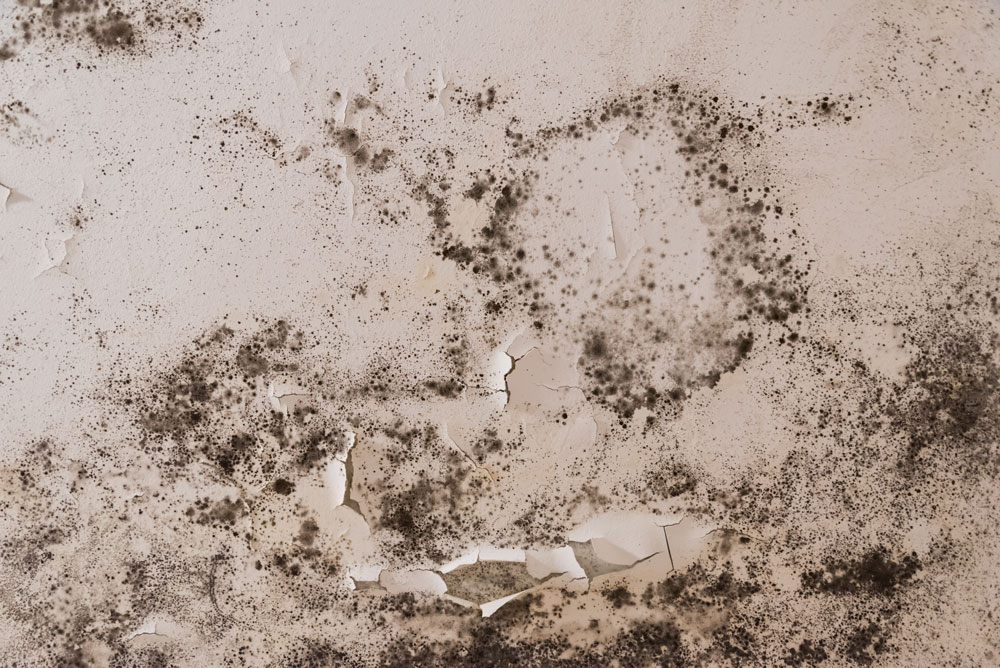How To Clean Mould Off The Ceiling
 CONTENTS
CONTENTS
- What causes mould on ceilings?
- The dangers of mould growth
- What to do if mould is growing on your ceiling
- How to prevent mould growing on the ceiling
- Get in touch
While you are looking for signs of mould growth in your grout and silicone, or on your windowsills, you might not realise that one of the most common places for it to grow is on the ceiling. Difficult to see and clean, it can quickly become a major problem and threaten to spread across your home.
At ICE Cleaning, we offer our mould removal services nationwide. Our nine-stage mould process can take care of your entire mould problem, from diagnosing the issue and eliminating it from your home, to advising on how to prevent it returning in the future.
Keep reading to learn why mould is growing in your home and the best way to clean mould off the ceiling.
What causes mould on ceilings?
Mould, a type of fungus, thrives in conditions where there is ample moisture and organic material. Ceilings often provide such an environment due to several reasons.
Firstly, humidity caused by daily activities like cooking or showering can rise and settle on a cold ceiling, resulting in condensation and making the surface damp. Leaks from roofs or upper-floor plumbing work can also contribute to this issue.
Poor ventilation and airflow encourages mould growth, too. When stale, humid air lingers, it can lead to dampness.
Even the building materials can trigger mould growth. Certain types like drywall or wood are prone to retaining moisture which gives these unwelcome guests something solid they can grow on and feed off. You can find out more about what causes mould to grow on ceilings in this blog.
The dangers of mould growth
Mould presents significant health risks, particularly to those with allergies or respiratory conditions. Inhaling, touching, and ingesting mould spores can cause allergic reactions and exacerbate asthma symptoms. Prolonged exposure may lead to more severe health issues such as lung infections.
On top of this, mould compromises the integrity of your home's surfaces. Painted walls and wallpaper can become discoloured and start peeling as a result of persistent mould growth. Should it start to grow on building materials, it can lead to structural problems in the future.
Another consequence of mould growth is how it hampers your living environment. Not only is it unsightly to look at, it produces an unpleasant, damp odour.
What to do if mould is growing on your ceiling
Mould on your ceiling can be a daunting sight, particularly if it is difficult to reach. The first step should always be to identify the cause of it so you can rectify the problem and take steps to prevent it growing back.
Next, bring in professional cleaners to treat the mould. They can also help you determine what caused the mould to grow.
Although cleaning mould off the ceiling yourself is tempting, you should avoid this. Firstly, mould cleaning without the right personal protective equipment may pose serious health risks.
Mould spores are notorious for being stubborn and difficult to clean, too. Cleaning from a height adds an extra layer of complexity and danger, and puts you at risk of falling and injuring yourself.
The wrong cleaning method, such as applying bleach, can lead to paint or wallpaper damage, as well. It may make the affected area look worse, such as discolouring the surface and failing to remove all the mould. Some techniques can even encourage mould to spread. Scrubbing, for instance, can aggravate the mould and cause it to release spores.
Professional mould cleaners can clean all the mould off the ceiling without causing additional damage to your property or spreading harmful spores throughout your home. They can safely reach hard to reach surfaces and use the right treatment for the most delicate materials.
How to prevent mould growing on the ceiling
Keeping humidity levels low and ensuring good air flow is fundamental for avoiding mould growth. There are lots of ways to encourage this in your home.
Firstly, invest in an effective dehumidifier and keep humidity levels below 50% all day.
You may also want to consider improving home insulation to ensure surfaces don't get too cold. You should turn the heating on or make sure the temperature does not fall below 14 degrees Celsius, either. This will reduce the chances of condensation forming.
Avoid drying clothes indoors without adequate ventilation as it creates moist conditions ideal for mould growth, as well. If indoor drying is unavoidable, ensure windows are open or extractor fans are running.
When cooking or washing, don't forget to use extractor fans and open windows to get rid of the steam and humid air.
As soon as you spot signs of early mould development, contact professional cleaners as soon as possible to have it remediated. You can find out more about the best ways to prevent mould growth in this blog.
Get in touch
We offer a lifetime guarantee* with every mould removal so should it come back after treatment, our technicians will return to site to remove it for free.
You can book our mould cleaners for our mould remediation services by calling 0208 066 0360 or sending an email to enquiries@icecleaning.co.uk.
*subject to advisories

Speak with me today,
I’m here to help
By asking you a few questions either via phone or email I can immediately provide a realistic estimation of the cost.
You’re in good company. We’ve cleaned for the following commercial clients… View all

Why choose us?
- Cater to a wide variety of cleaning situations
- Nationwide coverage, available 24/7
- Cater to commercial and domestic clients
- Free survey provided prior to quotation
- Emergency response team
- Offer a bespoke service designed to suit all your needs
- All technicians hold professional health and safety qualifications, including BICSc, IOSH, Dewpoint Professional & Safe Contractor
We’re fully accredited
We place best practise, professional expertise and health and safety at the core of our business. We’re fully compliant with all legal obligations. You can view a list of our accreditations below, or visit our Health & Safety page for more information.











-RGB-small.1707319151.jpg)




















